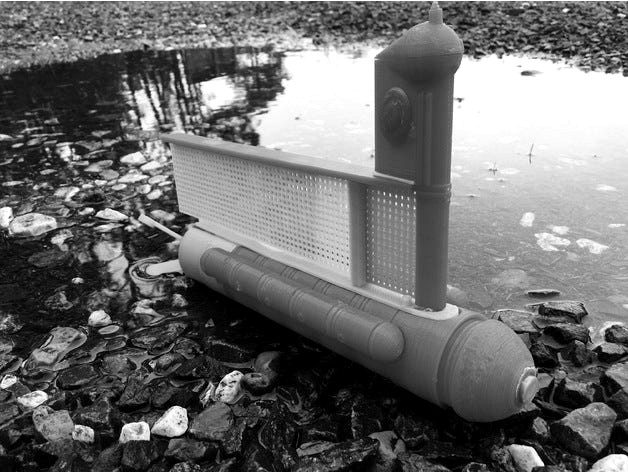Thingiverse

Kraken Mare Xplorer by themindseye
by Thingiverse
Last crawled date: 4 years, 7 months ago
This is a "near-scale" model of a proposed NASA robotic submarine that will be used for exploring the liquid ethane/methane lakes of Saturn's largest moon, Titan. It is a "near-scale" model due to the lack of detailed, measured drawings for this vessel--I only had two drawings for reference.
Titan is Saturn's largest moon and it is the second largest moon in our solar system. Titan was discovered in 1655 by Christian Huygens. The NASA Cassini-Huygens orbiter/probe entered Titan orbit in 2004 with the Huygens descent probe landing on Titan in January 2005. Titan has a methane cycle similar to Earth's water cycle. Lakes exist at high northern latitudes. Lakes and larger seas or mare are filled with liquid ethane and methane. An average, estimated (actual depth is unknown) depth of 20 m for these mare would be equivalent to twice the volume of Earth's oil and gas reserves.
The proposed submarine was designed by Ralph Lorenz for NASA Institute for Advanced Concepts (NIAC). There are three bodies of liquid ethane that are targeted for exploration: Kraken-1, Kraken-2, and Ligeia Mare. The large dorsal fin on the explorer is an X-Band Phased Array Antenna. Similarly, the discs on either side of the main mast fin are X-Band Omni Antenna.
This model was intentionally designed with numerous holes, channels, and ducts for enabling the vessel to completely submerge in a body of water (e.g., pool, bathtub, bucket, etc.). If you are interested in experimenting with the diving/surfacing abilities of this model, you can tape an Alka-Seltzer tablet inside the nose section. Carefully, poke a couple of small holes in the tape, thread the cap onto the Karken Mare Xplorer, and place the model in some water. As the vessel submerges, the water will activate the tablet and cause an explosion of gas to fill the interior of the ship enabling it to surface. This is an experimental feature of this model and it might not perform to your expectations. Good luck and have fun!
Tip: Use Testors Cement for Plastic Models No. 3512 for assembly. If you can't locate this product locally, consider ordering from: squadron.com.
References
"How I Came to Design Extraterrestrial Robot Submarines: Part 1 - Probing Saturn's Moon, Titan," Ralph Lorenz; SERVO Magazine, May 2015, pgs. 43 - 47.
"How I Came to Design Extraterrestrial Robot Submarines: Part 2 - Sailing Ligeia, Diving Kraken," Ralph Lorenz; SERVO Magazine, June 2015, pgs. 38 - 44.
"Titan Submarine : Vehicle Design and Operations Concept for the Exploration of the Hydrocarbon Seas of Saturn's Giant Moon," Ralph D. Lorenz, et.al., 46th Lunar and Planetary Science Conference (2015)
Parts List
4x - Ballast_Tank_Cap.stl
2x - Ballast_Tank_Xtra.stl - this part may require some post-print trimming
8x - Ballast_Tank.stl
Forward_Hull.stl
5x - Main_Hull.stl
Main_Mast_Fin.stl
Main_Mast.stl
Nose_Light_Lens.stl
Nose_Section.stl - this part may require a brim
2x - Omni_Antenna.stl
Rear_Hull.stl
4x - Strut.stl
Surface_Imager_Base.stl
Surface_Imager_Top.stl
Tail_Section_Exhaust.stl
Tail_Section.stl
X_Antenna_Aft.stl
X_Antenna_Base_Front.stl
X_Antenna_Base_Rear.stl
X_Antenna_Divider.stl
X_Antenna_Fore.stl
X_Antenna_Support.stl
Titan is Saturn's largest moon and it is the second largest moon in our solar system. Titan was discovered in 1655 by Christian Huygens. The NASA Cassini-Huygens orbiter/probe entered Titan orbit in 2004 with the Huygens descent probe landing on Titan in January 2005. Titan has a methane cycle similar to Earth's water cycle. Lakes exist at high northern latitudes. Lakes and larger seas or mare are filled with liquid ethane and methane. An average, estimated (actual depth is unknown) depth of 20 m for these mare would be equivalent to twice the volume of Earth's oil and gas reserves.
The proposed submarine was designed by Ralph Lorenz for NASA Institute for Advanced Concepts (NIAC). There are three bodies of liquid ethane that are targeted for exploration: Kraken-1, Kraken-2, and Ligeia Mare. The large dorsal fin on the explorer is an X-Band Phased Array Antenna. Similarly, the discs on either side of the main mast fin are X-Band Omni Antenna.
This model was intentionally designed with numerous holes, channels, and ducts for enabling the vessel to completely submerge in a body of water (e.g., pool, bathtub, bucket, etc.). If you are interested in experimenting with the diving/surfacing abilities of this model, you can tape an Alka-Seltzer tablet inside the nose section. Carefully, poke a couple of small holes in the tape, thread the cap onto the Karken Mare Xplorer, and place the model in some water. As the vessel submerges, the water will activate the tablet and cause an explosion of gas to fill the interior of the ship enabling it to surface. This is an experimental feature of this model and it might not perform to your expectations. Good luck and have fun!
Tip: Use Testors Cement for Plastic Models No. 3512 for assembly. If you can't locate this product locally, consider ordering from: squadron.com.
References
"How I Came to Design Extraterrestrial Robot Submarines: Part 1 - Probing Saturn's Moon, Titan," Ralph Lorenz; SERVO Magazine, May 2015, pgs. 43 - 47.
"How I Came to Design Extraterrestrial Robot Submarines: Part 2 - Sailing Ligeia, Diving Kraken," Ralph Lorenz; SERVO Magazine, June 2015, pgs. 38 - 44.
"Titan Submarine : Vehicle Design and Operations Concept for the Exploration of the Hydrocarbon Seas of Saturn's Giant Moon," Ralph D. Lorenz, et.al., 46th Lunar and Planetary Science Conference (2015)
Parts List
4x - Ballast_Tank_Cap.stl
2x - Ballast_Tank_Xtra.stl - this part may require some post-print trimming
8x - Ballast_Tank.stl
Forward_Hull.stl
5x - Main_Hull.stl
Main_Mast_Fin.stl
Main_Mast.stl
Nose_Light_Lens.stl
Nose_Section.stl - this part may require a brim
2x - Omni_Antenna.stl
Rear_Hull.stl
4x - Strut.stl
Surface_Imager_Base.stl
Surface_Imager_Top.stl
Tail_Section_Exhaust.stl
Tail_Section.stl
X_Antenna_Aft.stl
X_Antenna_Base_Front.stl
X_Antenna_Base_Rear.stl
X_Antenna_Divider.stl
X_Antenna_Fore.stl
X_Antenna_Support.stl
